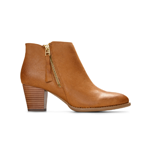
How to Tell if You Have Flat Feet

The term “flat-footed” is occasionally used to mean unprepared or caught off guard, but a slow reaction time is hardly an accurate diagnostic tool. The real signs are relatively simple. Foot aches, muscle pains, and even leg cramps are common symptoms of fallen arches—a condition two in ten adults live with on a daily basis.
With their prevalence and the potential foot pain they can cause, you may wonder how to tell if you have flat feet and if they’re doing your body any harm. Luckily, most people don’t even notice their collapsed arches. But if you suspect you may be flat-footed and are experiencing related issues, there are available solutions.
In this guide, we’re sliding the socks off flat feet to uncover their causes and effects, as well as offering some viable solutions to help you understand how to correct flat feet and identify associated symptoms.
Flat Feet Are Common in Our Younger Years
A logical follow-up to “Do I have flat feet?” is usually “How old are you?” Age has a major bearing on the depth of your arches, and, in our younger years, flat feet are nothing to worry about.
Believe it or not, almost all humans are born with completely flat feet. It’s not until we’re older that our arches begin to develop and deepen. Each individual’s foot growth is based on a combination of genetics, nutrition, and other factors, but researchers have observed some discernible patterns in arch development, categorized by age:
- Age three and under – By age three, just under half of all toddlers (46%) are beginning to develop their arches. So, if your little one is still flat-footed when they enter preschool, it’s no cause for concern.
- Age six – By this point, the majority of children (76%) have outgrown flat-footedness. If your child hasn’t, however, don’t be alarmed—there are still years of development to come.
- Age 12 – By the time you’re teetering in your teens, you should be well on your way to full arch development. If, by this point, your child is still flat-footed, there’s a solid chance you’ll be dealing with the foot condition throughout adulthood as well.
As mentioned, about 20% of people will remain flat-footed into their adult years. Exact figures, however, are difficult to pin down as pes planus presents itself differently in various populations.
Gender’s Role in Pes Planus
Men are almost equally as likely to have a flat right foot (21.2%) as a flat left foot (21.6%). Women, on the other hand, are more likely to have collapsed arches on their left side (28.2%) than their right (19.2%).
Meanwhile, if we take flat-footed to mean fallen arches on both sides, then the total flat-footed population would sit at only around 13.6%.
Regardless, gender certainly isn’t the largest determining factor in whether or not an adult develops flat feet. So, with that said, what are the main causes of collapsed arches as we get older?
What Causes Flat Feet?
If you’re worried you never outgrew pes planus as a child and are wondering, “How do I know if I have flat feet?” there are a variety of risk factors you can look at to determine your susceptibility to this foot problem.
First and foremost, there’s a strong correlation between flat-footedness and genetic inheritance. So, if your parents have or had flat feet, there’s a solid chance you will too.
Just because flat feet can be genetically inherited, however, it doesn’t mean you’re automatically destined for pes planus if your family has it. There are a variety of other risk factors that can contribute to the foot condition, including:
- Obesity – Excess body weight applies more downward pressure on our feet, flattening our arches and resulting in a higher chance of pes planus as we age.
- Pregnancy – Like obesity, pregnancy adds extra weight to our bodies and pushes down on our arches in the same manner.
- Aging – As we get older, the ligaments in our arches tend to stretch out, putting us at a higher risk of pes planus, especially when coupled with other risk factors.
- Injury – A major injury to your ligaments or tendons can cause your arches to flatten out almost instantly, resulting in significant pain and, potentially, pes planus.
- Arthritis, diabetes, and tendonitis – A variety of health conditions can lead to a higher propensity to develop flat feet. To reduce your chances, keep an eye out for these illnesses that can weaken our bodies and result in pes planus.
Even with genetic susceptibility and these risk factors, however, there’s still no guarantee that you’ll develop pes planus. The only way to tell for sure if you have a flat foot arch is to check your feet for yourself. Luckily, there are a couple of easy tests that you can perform in the comfort of your own home.
How Do You Know If You Have Flat Feet? (Two Simple Tests)
While it’s recommended to consult a doctor for their professional opinion on all health matters, it’s simple enough to perform self-checks for flat feet. Then, you can schedule an appointment with your care provider and discuss your concerns at the appointment.
Below, we’ll outline two quick tests you can perform to investigate your foot arches.
The Standing Test
Simply stand up tall in front of a mirror or friend and make note of how your feet make contact with the floor. Make sure you—or your friend—can see the inside of your foot.
This test can help you decipher if you have a fallen arch, a high arch, or something in between. If the bottoms touch the ground completely, that’s a key sign of pes planus. If, however, there’s a noticeable arch, you’re likely in the clear.
The Wet Foot Test
If visual inspections are proving difficult, running this easy test may more accurately help you determine if you have pes planus. To begin:
- Prepare a dry surface that will clearly show a wet footprint, such as paper or concrete.
- Wet your feet in the bath or shower, or with a hose.
- Step onto the dry surface with both feet and stand up as straight as possible.
- Examine your footprints to determine whether or not you have fallen arches.
If you can see the entirety of your foot imprinted onto the dry surface, chances are you have flat feet. If you can clearly see a missing portion where your foot doesn’t make contact with the surface, however, you likely have normally developed arches.
How Can Flat Feet Affect Your Health?
As mentioned, most people with flat feet don’t experience significant health issues from their condition. Some doctors suggest only 10% of flat-footed individuals actually deal with any related issues. Amongst those people, the most common symptoms include:
- Pain in your midfoot, lower leg, heel, knee, hip, and/or back
- Involuntary muscle spasms, particularly in and around your ankles
- Difficulty walking and running that forces you to alter your gait to accommodate the pain
- Foot deformities
- Swelling of the foot, ankle, and lower leg
- Inflammation in the collapsed arch area
If you’re experiencing these or similar symptoms, it may be a sign that you have flat feet. If you believe pes planus could be affecting your health, perform a self-check, consult a doctor, and begin taking steps to mitigate the issue.
How To Treat Flat Feet
If you have a hunch that you have flat feet but aren’t entirely certain, your first step should be to consult a licensed podiatrist and hear their expert opinion. Oftentimes, podiatrists will be able to confirm your self-diagnosis and offer treatment options to help alleviate the associated pain.
One common way to deal with flat feet is with orthotic shoe inserts. Podiatrists will often prescribe them to their patients with pes planus as they can help with the symptoms of flat feet. Similarly, they may also suggest purchasing walking shoes with arch support that help lift your feet in the same way a natural arch does, which helps to alleviate any foot pain or discomfort.
Arch support is essential for people with pes planus. Unfortunately, it can be difficult to discern which footwear brands actually provide the necessary padding under your soles while still being comfortable on the heels, toes, sides, and top of your feet.
Walk with Vionic to Alleviate the Pains of Pes Planus
You’ve already answered, “How to tell if I have flat feet?” Now it’s time to ask, “What are the best shoes for flat feet?”
First, meet Vionic.
Vionic crafts a plethora of sleek, supportive footwear, insoles for women’s shoes, and orthotics for men in a variety of styles to fit anyone’s aesthetic. For the sporty amongst us hoping to reclaim our love of walking once again, the Walk Max Lace Up Sneaker provides premium support for those morning jaunts or late-night strolls.
For those after a more youthful yet classic look, the Winny Sneaker combines the flat-bottomed aesthetic of skate shoes with ample lower padding to deliver the support we all need as we age. Or, the Kearny Platform Lace Up Sneaker bridges the gap between casual skate style and peak performance shoe while offering the same essential support as the rest of our collection.
Vionic offers some of the best shoes for individuals with flat feet, and every single pair we produce features cushy comfort and unparalleled arch support. Browse our entire collection to find a style that matches you.
Sources:
Cleveland Clinic. Flat Feet. https://my.clevelandclinic.org/
National Library of Medicine. Prevalence of flatfoot in school between 3 and 10 years. Study of two different populations geographically and socially. https://www.ncbi.nlm.nih.gov/
National Library of Medicine. Pes Planus. https://www.ncbi.nlm.nih.gov/.
Columbia Broadcasting System. Flat Feet Are More Common Than You Might Think. https://www.cbsnews.com/
National Library of Medicine. The effects of short foot exercises and arch support insoles on improvement in the medial longitudinal arch and dynamic balance of flexible flatfoot patients. https://www.ncbi.nlm.nih.gov/









